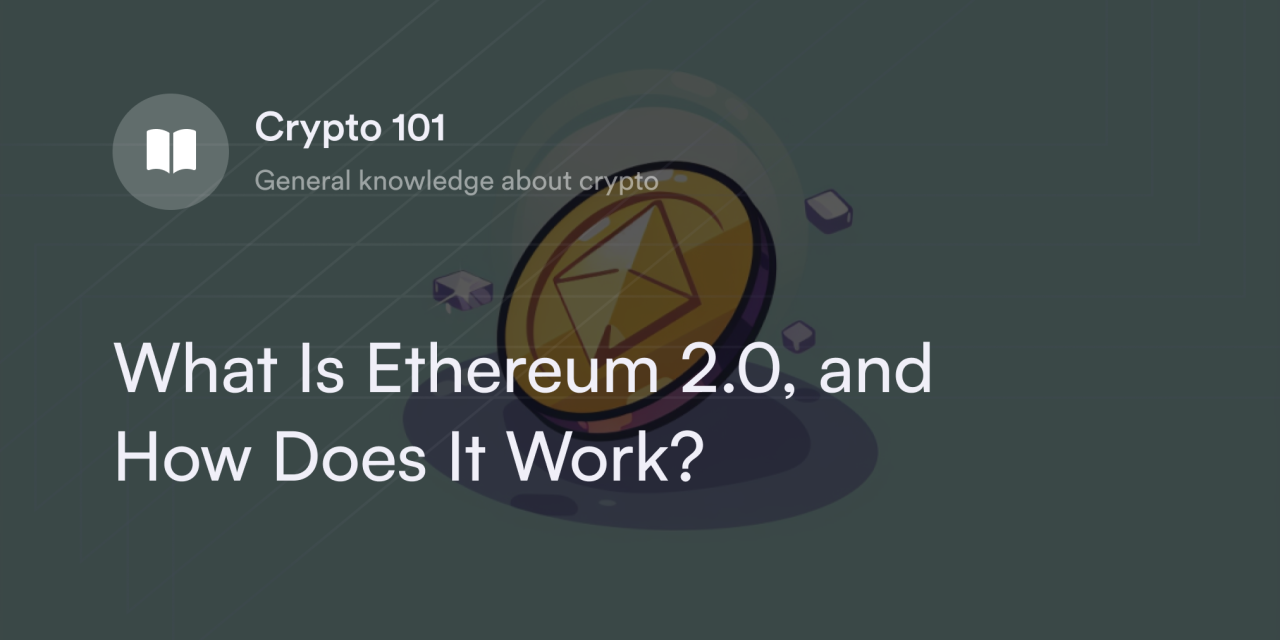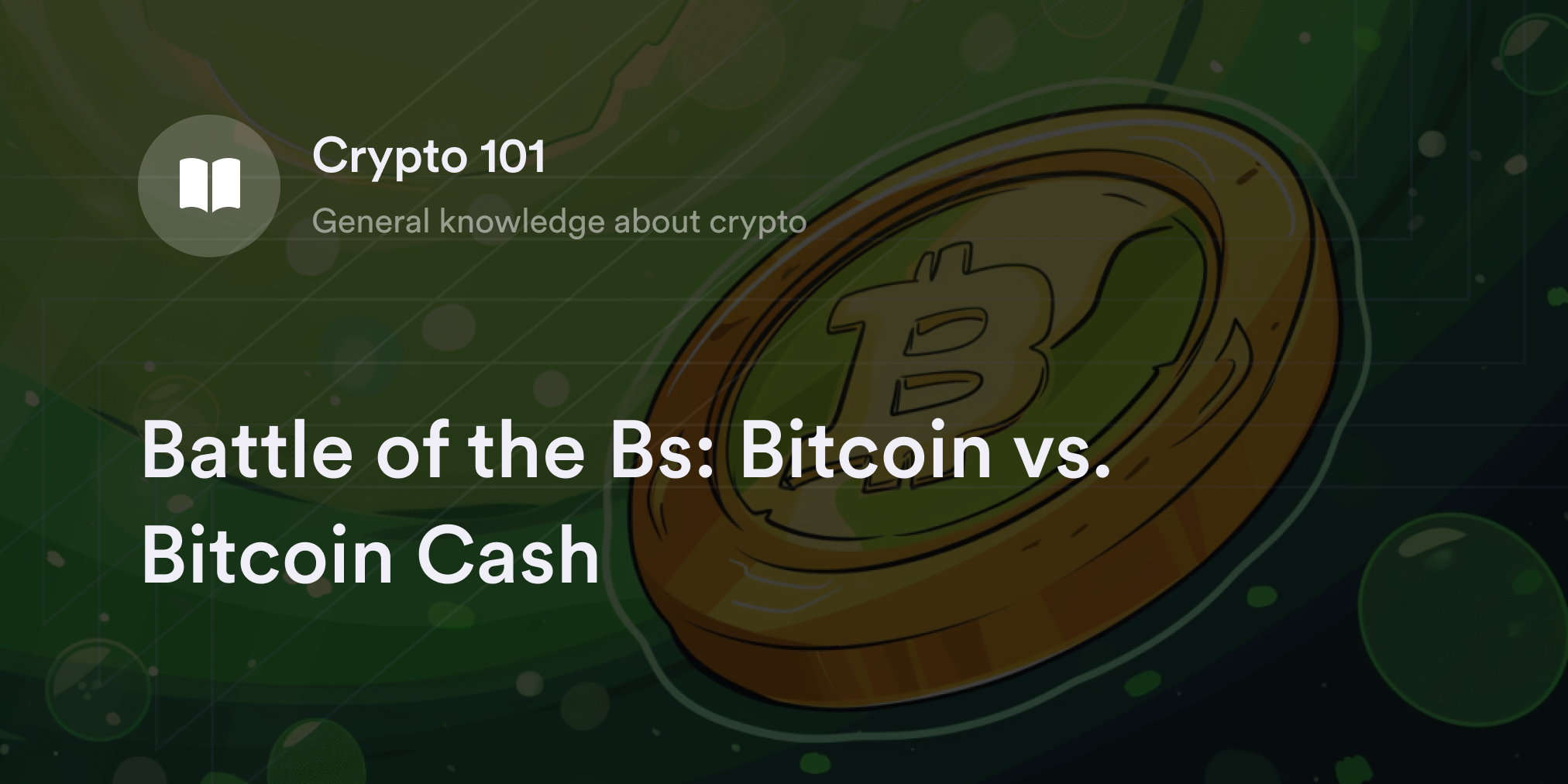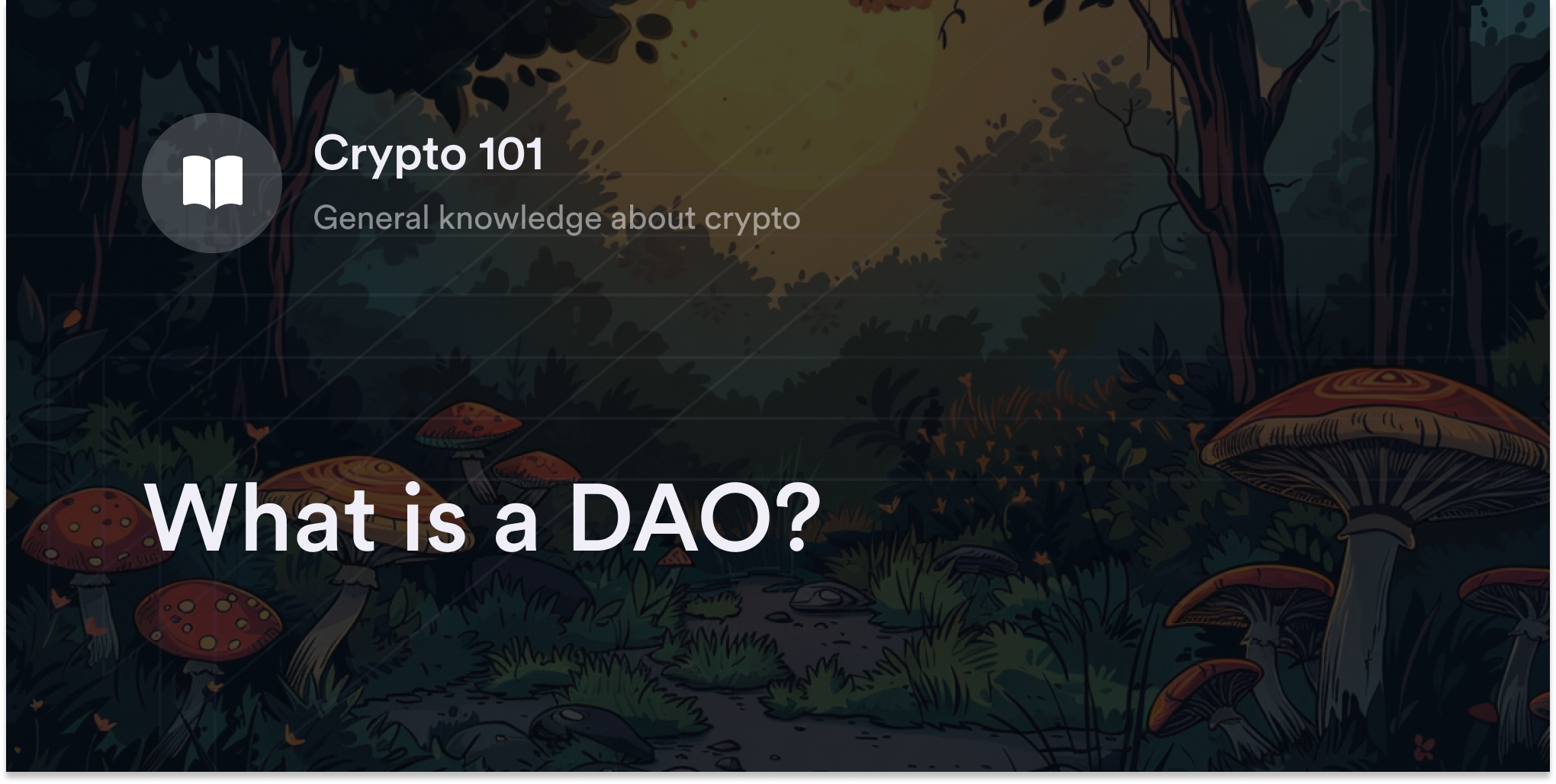


Ethereum (ETH) is arguably as influential as Bitcoin (BTC) in the history of cryptocurrency. ETH broadened the potential use cases for Bitcoin’s signature decentralized consensus system, although its blockchain wasn’t the first successful peer-to-peer (P2P) digital currency. Instead of solely using blockchain networks to record P2P payments, the Ethereum team created a massive “global supercomputer” with the potential to decentralize internet applications.
In September 2022, Ethereum evolved significantly by changing how computers on its blockchain reach consensus and post new transactions. The move was so groundbreaking that many in the crypto community believe the post-2022 “Ethereum 2.0” has the potential to attract more developers, investors, and users into the Web3 ecosystem.
Learn what Ethereum 2.0 is, how it differs from Ethereum, and how it has impacted the crypto community.
What is Ethereum 2.0? A refresher on Ethereum
Before getting into Ethereum 2.0, let’s review what the Ethereum blockchain is.
Since its launch in 2015, Ethereum has established itself as the dominant smart contract, decentralized crypto protocol. First introduced on Ethereum, smart contracts are blockchain-based programs that understand and execute pre-coded commands. Thanks to smart contract technology’s decentralization, third-party developers can build decentralized applications (dApps) on Ethereum’s blockchain. These dApps function similarly to current web-based applications (e.g., Facebook or Twitter) but without big tech companies, governments, or other centralized institutions behind them. Instead, dApps use smart contract code and the consensus layer of Ethereum’s main blockchain to provide users with a trustless, automated, and P2P online experience.
Ethereum has had many upgrades throughout its history, but Ethereum 2.0—which began with “the Merge” in 2022—fundamentally changes the blockchain’s core consensus mechanism. Think of the consensus mechanism as a set of rules computers must follow to process transactions and record data. Earlier, Ethereum used a proof-of-work (PoW) consensus mechanism similar to Bitcoin. On PoW blockchains, computers (or nodes) solve complex algorithms every few minutes to post new transactions on the cryptocurrency’s payment ledger and receive crypto rewards. The first milestone in the Ethereum 2.0 roadmap began with “the Merge.” The Merge moved Ethereum from a PoW consensus mechanism to a Proof of Stake (Pos) consensus mechanism. Unlike PoW blockchains, a PoS system’s nodes lock (or stake) cryptocurrency on the main blockchain to validate transactions and collect ETH as compensation.
Ethereum made this change primarily for scalability. Leading Ethereum developers such as Vitalik Buterin believe the PoS consensus model addresses issues such as slow transaction speeds, network congestion, and high gas fees on Ethereum’s blockchain. Reports on the average transaction costs following Ethereum’s transition to PoS suggest it’s already impacting ETH gas fees. For example, data from YCharts found the average Ethereum gas fees dipped by 93% between May and September 2022. The PoS Ethereum blockchain also confirms new batches of transactions in 12-second intervals versus the 13–14-second intervals of the older blockchain. The development team at the Ethereum Foundation believes PoS provides a better template to enhance these efficiency benefits with further software applications.
Note: Although most publications use Ethereum 1.0 versus Ethereum 2.0 to describe the switch from PoW to PoS, the Ethereum Foundation prefers the “execution layer” versus the “consensus layer.” Ethereum’s leadership believes this new terminology better reflects the network’s shift to PoS without implying the consensus layer is a new blockchain. The Ethereum Foundation also hopes to rebrand from “ETH2” to the “consensus layer,” reducing the risk of scams trying to sell “updated” ETH2 tokens to novice crypto investors.
How does PoS Ethereum work?
Validators on Ethereum 2.0 need to lock at least 32 ETH on the main blockchain to process payments on the network. ETH2’s algorithm randomly chooses a different validator to complete a block of transactions 7,200 times per day. Whenever a validator broadcasts new ETH payment data, they receive ETH rewards in their crypto wallet. The average ETH reward distribution depends on how many validators are on the Ethereum protocol at any given moment.
To reduce the risk of invalid data, Ethereum 2.0 uses a slashing system to punish bad actors. If the PoS algorithm discovers a validator node submits false information, it automatically removes or slashes their staked cryptocurrency from the blockchain. Validators who go offline or neglect their staking duties are also at risk of facing slashing penalties.
What is the difference between Ethereum and Ethereum 2.0?
The key difference between Ethereum and Ethereum 2.0 is that the latter uses PoS rather than PoW. However, this doesn’t mean Ethereum 2.0 instantly becomes a faster and cheaper version of the original blockchain. Immediately following its transition to PoS, Ethereum 2.0 experienced no change in its fee structure and only negligibly quicker transaction speeds.
However, the shift to Ethereum 2.0 dramatically affects the blockchain’s environmental impact. On one hand, PoW blockchains, such as Bitcoin, need significant electrical power to figure out the protocol’s advanced computations. Conversely, PoS blockchains don’t require large computers (“rigs”) solely to solve complex equations and post new transactions. Instead of running crypto mining rigs day and night, Ethereum’s PoS validators install and run the blockchain’s software on their computer, link their crypto wallet, and stake ETH on the blockchain. Although Ethereum validators need to keep their computers constantly running to validate blocks, they don’t have to use as much energy to solve the equations in a PoW model. In fact, the Ethereum Consensus Layer consumes 99.95% less energy than the execution layer, according to the Ethereum Foundation.
Another significant difference between Ethereum and Ethereum 2.0 is that the latter has a lower coin issuance schedule. Pre-ETH2, the Ethereum protocol minted approximately 14,700 ETH every day. After switching to PoS, daily issuance dropped to 1,700 ETH. Also, thanks to the EIP-1559 upgrade in 2021, Ethereum destroys or burns a portion of every transaction fee on the blockchain. Whenever the burn rate on Ethereum 2.0 exceeds 1,700 ETH per day, ETH becomes a deflationary digital asset.
When will Ethereum 2.0 launch?
Ethereum 2.0 launched on September 15, 2022, during “The Merge,” when Ethereum’s execution layer transitioned all its data to a PoS chain called the “Beacon Chain.” Buterin introduced the Beacon Chain in December 2020 as a PoS blockchain mirroring the existing Ethereum PoW network. In the years leading up to The Merge, the Ethereum Foundation let crypto investors stake 32 ETH on the Beacon Chain to support the new blockchain’s decentralization and earn staking rewards.
Although The Merge marked the switch to a PoS consensus, Ethereum 2.0 is still under development. According to Buterin, Ethereum will undergo the following five transitions before completion:
The Surge: Set to launch in 2023, The Surge adds “sharding” capabilities to the Ethereum ecosystem. As the name implies, sharding breaks down data on the Ethereum blockchain into smaller units, removing some of the pressure from the mainnet and hopefully speeding up ETH transactions.
The Scourge: During this stage, the Ethereum Foundation says its focus is enhancing user safety by increasing censorship resistance and making transaction data more difficult to exploit versus the current Maximum Extractable Value (MEV) system.
The Verge: This refers to an advanced cryptographic proof model called “Verkle trees.” The event aims to use the Verkle tree design to reduce validator data requirements, improving accessibility to ETH staking and promoting decentralization.
The Purge: During The Purge, Ethereum’s core developers plan to wipe out old and unnecessary data to free up more storage space. At this stage, Ethereum 2.0 may hit its target of processing more than 100,000 transactions per second (TPS).
The Splurge: Although it’s unclear what will happen during The Splurge, Buterin ensures crypto fans that it’ll be a lot of “fun.”
What is delegated Ethereum 2.0 staking?
Investors need to stake 32 ETH to validate transactions on Ethereum, but anyone can “delegate” below 32 ETH to join the Ethereum 2.0 network. Delegation means depositing a PoS cryptocurrency into a validator’s staking pool to earn a crypto reward percentage. Many third-party providers––such as crypto exchanges, wallets, and DeFi lending sites (e.g., Lido Finance)––offer Ethereum 2.0 delegation services. Although ETH delegators won’t enjoy the voting privileges validators get in on-chain governance proposals, they don’t have the same responsibilities for confirming transactions. Remember, delegators are at risk of slashing if their validator goes against Ethereum’s PoS protocol. In this scenario, delegators lose all their ETH if the validator they stake with misbehaves or makes an error.
How does Ethereum 2.0 affect ETH coins?
The shift to PoS doesn’t affect the code behind Ethereum’s native ETH cryptocurrency. The Ethereum Foundation warns against scammers telling crypto traders “how to buy Ethereum 2.0 coins” or claiming users must upgrade their ETH1 to ETH2. The same rule applies to all Ethereum-based tokens, including fungible tokens like LINK or UNI and non-fungible tokens (NFTs) like CryptoPunks. Every native coin and token in the Ethereum protocol automatically transitioned to the consensus layer after September 15, 2022.
Stay tuned for ETH updates on dYdX
Since The Merge, traders constantly monitor the latest updates on Ethereum 2.0’s roadmap. For the latest info and education on crypto projects like Ethereum, visit dYdX’s blog and Academy. Our beginner-friendly guides bring you up to date on hi-tech crypto innovations, such as DeFi, NFTs, and smart contracts.
dYdX also offers eligible traders decentralized Ethereum perpetual swaps with up to 20x leverage for those interested in trading ETH.
Eligible traders can start trading on dYdX today!
Disclosures
The opinions and information presented in this article (the “Article”) are provided for general information purposes only. Reference to any specific content, product, service, or entity does not constitute an endorsement or recommendation by dYdX Trading Inc., or any affiliate, agent, or representative thereof (“dYdX”). The content provided in this Article is for informational purposes and does not constitute, and should not be considered, or relied upon as, financial advice, legal advice, tax advice, investment advice, or advice of any other nature; and the information in this Article is not a call to action to make any investment, or purchase any crypto asset, of any kind (collectively, the “Service”). By using the Service, you agree that you are responsible to conduct independent research, perform due diligence, and engage a professional advisor prior to taking any financial, tax, legal, or investment action related to the subject matter hereof. You may only use the dYdX interface in compliance with the dYdX terms of use available here, including the geographic limitations therein.
Any applicable sponsorship will be disclosed, and any reference to a sponsor in this Article is for disclosure purposes, or informational in nature, and in any event is not a call to action to make an investment, acquire a service or product, or purchase crypto assets. This Article does not offer the purchase or sale of securities. By using the Service, you agree that dYdX is not responsible, directly or indirectly, for any damage or loss incurred by you in connection with the use of or reliance on the Service, including any content, products, services, or entity mentioned in this Article.







